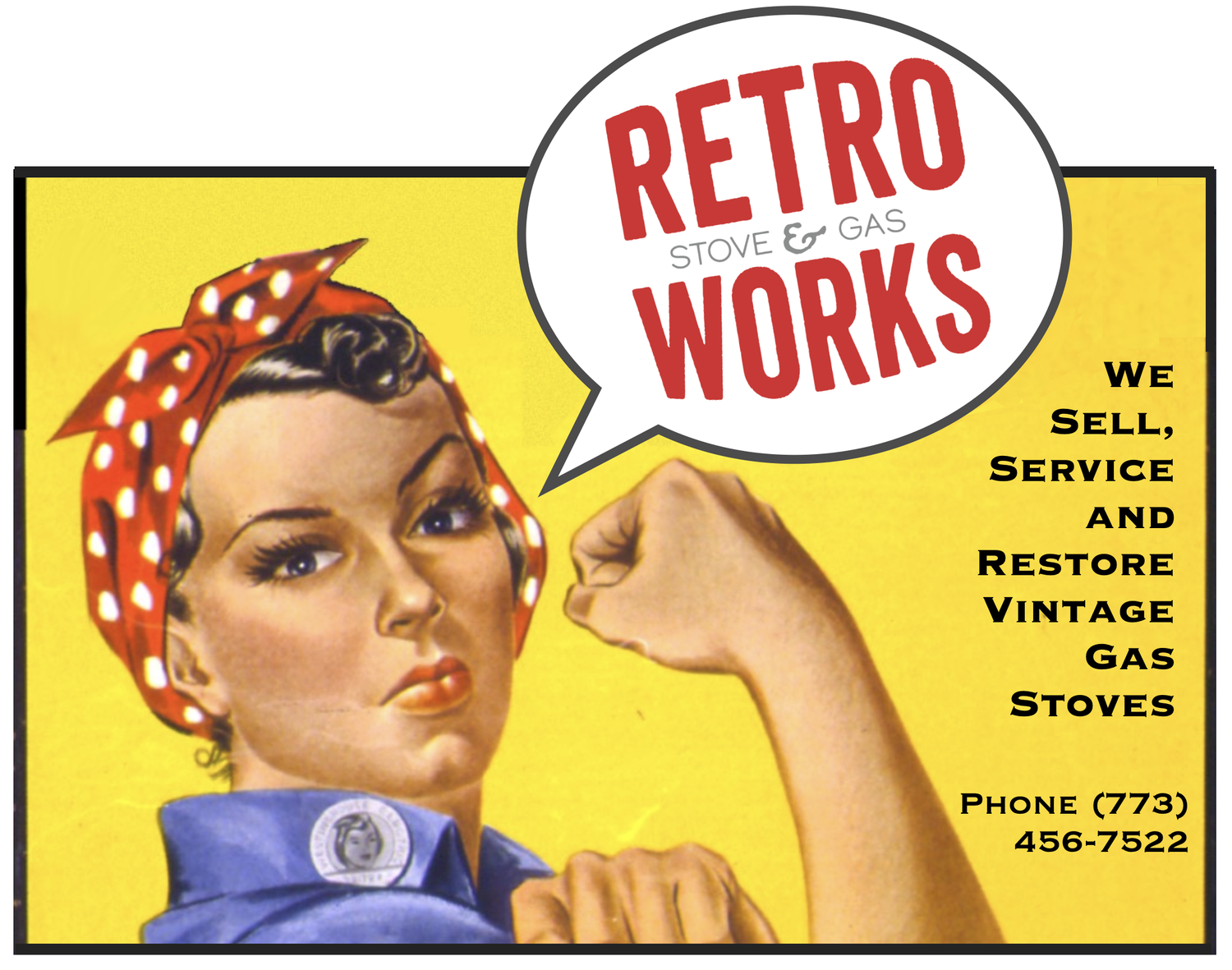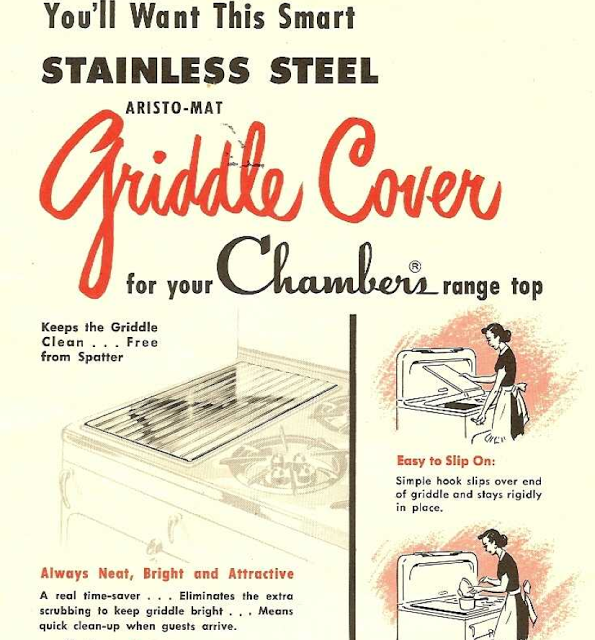Of all the features Chambers offers, most of the calls I get concern the In-A-Top Broiler/Griddle. And of those calls, the most common question is "My griddle is disgusting! How do I keep it clean?"
Well, "Clean" is a relative term, and like Beauty, all in the eye of the beholder.
Let's start with the Model B we've got in our kitchen. Bacon and pancakes has always been our son's favorite breakfast. He's 14, so I've been cooking that meal on that griddle about twice a week for over a decade. Plus, I'm always using the broiler for roasting red peppers, eggplant, zucchini, and occasionally animal flesh.
How's the griddle look? Judge for yourself:
The griddle, broiler and burners of a vintage Chambers stove model B, as well as the folding cover.
Not exactly pretty, but since I use it so frequently, and the rest of the cooktop is in original (well-worn) condition, I'm fine with how it looks.
The blackened griddle covering the broiler of a vintage Chambers stove model B
Now check out the griddle of my friends Tom and Nancy.
I think Tom and Nancy don't just cook on their griddle: they must live on the darn thing. When I first worked on their stove and offered to clean the griddle, I was blown away when they declined. They didn't just say "no": they were adamant that I not touch it. They love it just as is.
A polished griddle on a restored vintage Chambers stove model 90c
Then there's my buddy Jim. Believe it or not, THIS griddle isn't new: Jim and his wife have been cooking on it for themselves and their kids, keeping it this good looking for almost a decade. How do they do it? More on that soon.
My point is, every Chambers owner perceives and likes things different. Depending on one's tastes, the condition of the cooktop, how one cooks on the stove, etc., it's hard to give out a single line of cleaning advice that applies to everyone. So, I'll offer maintenance suggestions for just a few situations and hope that satisfies most of anyone looking here for help.
Front view of Model B Chambers vintage stove with black cooktop showing broiler under griddle and pots in Thermo-Well
CHAMBERS' ORIGINAL SOLUTIONS:
If you REALLY hate to clean, you couldsimply own what we in the biz call a Stealth: a Model A, B, or BZ with a black porcelain cooktop instead of chrome. All six versions of each model sport a nifty folding cover: when done cooking, it folds down to conceal not only the griddle, but the entire cooktop, hiding lax maintenance from view. The three Stealth versions go one further: the black cooktops do a great job of making blackened, baked-on surface grime practically invisible. How awesome is that? With filth thus concealed, hubby would be none the wiser that his lovely house spouse, in crisp pressed apron serving canapés to his dear old mother, was literally a slovenly Mrs. Hyde.
All that changed with introduction of the model C in 1949, when Chambers deprived deceptive cooks of their easy outs: the folding cover AND black enamel cooktop option were gone. The "Aristo-Mat", a skimpy little sheet of stainless steel to cover just the griddle, was all they were left with.
Sure, it did its job, but the rest of the shiny chrome cooktop was now 24/7 open to scrutiny. No wonder female angst was about to explode in the Women's Liberation movement the next decade. Yes, Aristo-Mat covers can still be found, but they are almost always pretty beat up. Better than nothing, I suppose, in the same way as a bad toupee.
So what's a Chambers house spouse to do, now that it's 2015? The icecaps are melting, people actually think a rich reality TV personality should lead the hope of the free world, and we are still worried about what our Chambers griddles look like. Are we geeks or what?
The most effective place to start is also the easiest: make sure, after every use of any cooktop burner, that you wipe off the griddle with dish soap and clear water. Same thing right before use of the griddle/broiler. Browned or blackened schmutz stains on your griddle will be avoided if the schmutz isn't there in the first place when that monster is fired up. As for other griddle maintenance strategies, I offer the following:
ONE POLISHED
Just gotta go glitzy? Fine, but you must first get your griddle polished, by a professional. Don't do it yourself: you are not good at it, and it involves dangerous machinery. Send it to me: I'll take out all the dents and warpage and return it looking brand new.
As for maintaining the shine, I have absolutely no clue, because I've never practiced that religion. I'm am sure one should not touch it with metal utensils, abrasive pads or scouring powder. Actually cooking on it? Probably a bad idea.
Restored Vintage Chambers stove model 90C highback set in a vintage kitchen with subway tiles and cork floor.
Yes, my friend Jim says that he uses his griddle all the time and it somehow emerges from the sink as shiny as the day it was polished, but c'mon, look at his kitchen: I'd bet that every speck of cooked food in that house has been delivered. I like Jim and trust him on everything else he tells me, but we all have one dark secret so I let him slide on this.
ONE POLISHED
For those with newly re-chromed cooktops and messy and/or lazy kitchen habits, you may want to go the way many of my clients have gone. Opt for two griddles: a working griddle for actually cooking on, and a polished "show" griddle, never to be cooked on, kept for when judgmental company or in-laws come over. This might seem excessive to some, but if I had a re-chromed cooktop, I'm not sure I could stand having a work-a-day griddle sullying up so much prime real estate while the stove was idle.
ONE "WORK-A-DAY"
For the majority of Chambers owners with original condition cooktops, a spangly griddle might have the lipstick-on-a pig-effect, making the rest of any work-a-day Chambers look worse. So be content with your one working griddle. It's really fairly easy to keep it clean by doing what the Chambers owner's manual suggests, with a slight revision.
The manual's basic philosophy is to clean the griddle after every use, while it is still hot. Not blazing hot, right off of the fire, but hot enough that you definitely need hot pads to take the thing off and set it in your sink filled with dishwater.
The manual suggests using Brillo pads, but I've found 3M Scotch-Brite scrub sponges to have the best balance of scouring/polishing qualities: The yellow sponge portion of the pad holds plenty of dish soap, while the green scouring portion of the pad is aggressive enough to abrade off most hardened or semi-hardened grease from the griddle. Yet it leaves the aluminum smooth enough so that the "seasoned" quality of the surface remains, ensuring that eggs, pancakes and the like won't stick. (Of course you still need some sort of fat, in or under whatever you are cooking, to keep it from sticking).
This method, or at least the half-hashed way I go about it, never gets every spot off the griddle, and eventually, just like the cooktop surface itself, the grunge spreads and builds up. Once or twice a year, fed up with how disgusting it all looks, I turn toward modern chemistry to make my life as a Chambers house spouse more meaningful and rewarding.
Easy-Off oven cleaner is the way to go. Not the nasty stuff in the yellow can: that Alien blood works fast but is so noxious and scary you don't want to mess with it. Protective clothing? I'm thinking Haz-Mat gear.
The Easy-Off you want is the one in the blue can. It works a lot slower, but it is very low fume, so one may actually inhabit the house while it's working. And yes, wear rubber gloves, safety goggles, long sleeves etc.
Stick your griddle in a plastic garbage bag, spray it down with the product, then close the bag to let the griddle soak (the stuff only works when it's wet), from two hours to overnight, depending on how crusted your griddle starts out. Add the action of the Scotch-Brite scrubber, and you've got your nice clean griddle back! You will have to re-"season" the griddle at this point because that layer of fat has been chemically and physically removed from the griddle's surface, but that just requires you to cook a mess of bacon (or moderately heat the griddle after rubbing in some Crisco or bacon grease). When using Easy Off in the blue can, remember that the less time the better, because the cleaner tends to turn exposed aluminum grey. Do not let the stuff dry on bare aluminum: that's really hard to clean.
ONE GRUNGY
Now, for those of you who never clean your cast iron pans, don't want to use any chemicals, or have opinions around aluminum contacting your food, you can do what my buddy Tom does: never clean your griddle. Well, never thoroughly clean your griddle. I can't imagine such an approach to cooking, but I've seen enough blackened griddles to know that plenty others can. Layer by layer, meal by meal, the grunge gradually coats the aluminum to the point where it looks like cast iron, and probably weighs just as much. Who cares what your judgmental friends and relatives think? It's been ages since they swore off coming to your house for dinner anyway.








